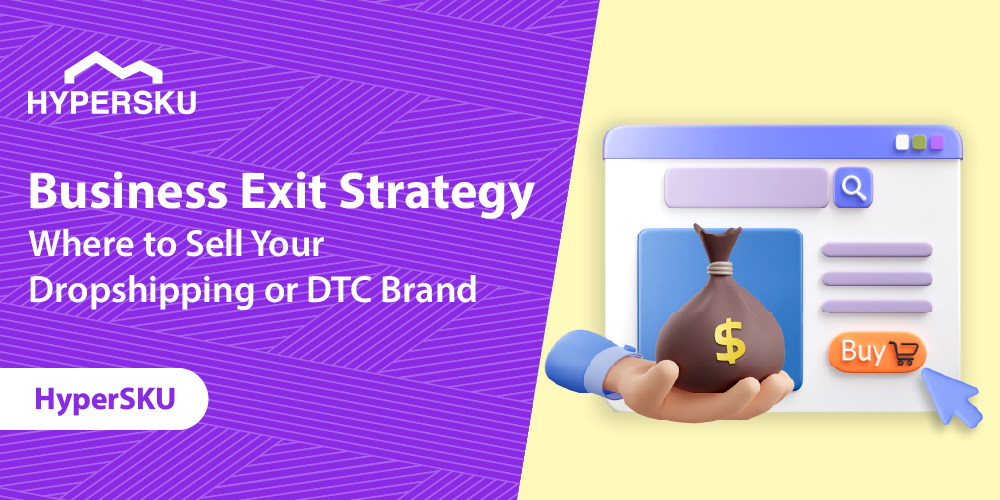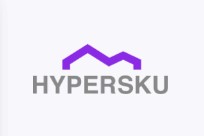Business Exit Strategy: Top 5 Platforms to Sell Your Online Business
Looking to exit your dropshipping or DTC brand? In this guide, we compare 5 top platforms to sell your online business—from beginner-friendly marketplaces to full-service brokers. Learn what makes your store attractive to buyers and how to prepare for a smooth, profitable exit.


HyperSKU
Posted on July 04, 2025
No one starts an e-commerce business thinking about the end. But whether you’re running a dropshipping store or building a DTC brand, having a clear business exit strategy is just as important as your growth plan.
People exit their businesses for many reasons:
- Maybe your store has hit a plateau or you’re burnt out from handling daily orders, customer support, and ad campaigns.
- Maybe it’s simply time to cash out on the value you’ve built.
Recent data shows this lack of preparation is common—and risky:
- In 2023, 48% of business owners who want to sell had no formal exit strategy
- That same report found only 17% had a written exit plan
These statistics paint a clear picture: many owners aren’t planning ahead—and without a solid strategy, even profitable stores can fail to sell, or worse, fail altogether.
That’s why a business exit strategy isn’t a luxury—it’s a necessity. It turns your hard work into a real financial outcome, rather than letting it fade away.
In this guide, we’ll walk you through the essentials of a smart e-commerce exit:
- What a business exit strategy actually means
- Where to sell your dropshipping or DTC brand
- How to maximize your store’s value before the sale
Let’s get started — and make your business exit a profitable one.
What Is a Business Exit Strategy?
A business exit strategy is a planned approach for transitioning out of business ownership. It outlines how you intend to either sell, merge, close, or otherwise transfer your business when the time comes.
For dropshipping and DTC (direct-to-consumer) brands, this often means selling the entire business as a packaged asset—this may include:
- Your brand identity and assets
- Customer database and email lists
- E-commerce storefront (Shopify, WooCommerce, etc.)
- Social media accounts and advertising platforms
- Supplier relationships and logistics systems
- Standard operating procedures (SOPs), automations, and staff (if applicable)
An exit strategy is not simply about shutting down—it’s about capturing the value of the business you’ve built and transitioning it in a way that aligns with your long-term goals.
Why Exit Strategy Matters for Dropshipping/DTC Sellers
Compared to traditional retail businesses, e-commerce brands—especially dropshipping operations—tend to be:
- Scalable and relatively low overhead
- Fast to build, but highly dependent on traffic sources (especially paid ads)
- Easier to transfer to a new owner due to the digital nature of assets
However, they also come with challenges that can complicate a potential exit:
- Operations may lack documentation or structure
- Margins can be thin and depend heavily on ad efficiency
- Buyers may hesitate if customer relationships and brand equity aren’t strong
Planning your exit early gives you time to stabilize operations, document processes, and improve your financial performance, so when the time comes, you’re ready to sell at a fair (or premium) valuation.
Common Exit Options for E-Commerce Sellers
When planning to exit your dropshipping or DTC business, choosing the right platform to sell your store is crucial. Each marketplace or broker offers different benefits depending on the size of your business, your timeline, and your specific needs. Below is a comparison of five leading platforms, followed by detailed descriptions to help you decide which one suits your exit strategy best.
Comparison Table
|
Platform |
Minimum Requirements |
Ideal Sellers |
Fees |
Key Features |
|
Avg. $2,000/month net profit (12 months) |
Mid-size DTC/Dropshipping |
High commission + strict vetting |
High-quality buyers, formal vetting process |
|
|
No minimum |
Beginners, small sellers |
Listing fee + success fee |
Large buyer base, quick listing |
|
|
$100K+ TTM revenue (ideally $5M+) |
SaaS / established eCom brands |
Free listing + success fee |
Fast acquisition, investor network |
|
|
$500/month profit + 12-month history |
Mid- to high-end sellers |
Tiered success fees |
Full-service exit advisory, vetted buyers |
|
|
ShopBroker / Others |
Flexible |
Local sellers, special cases |
Custom project-based fees |
Hands-on assistance, niche market knowledge |
Here are more details & breakdowns about the platforms mentioned above.
Empire Flippers
Empire Flippers is a leading curated marketplace for online business acquisitions. They require sellers to show at least $2,000/month in average net profit over a 12-month period. Ideal for mid-sized DTC or dropshipping businesses with stable earnings and clean operations.
Pros:
- Rigorous buyer vetting ensures quality offers
- Hands-on sales process with support from advisors
- Offers a valuation tool and migration assistance
Cons:
- High commission rates (up to 15%)
- Lengthy vetting period before listing approval
Flippa
Flippa is the most accessible platform on this list, with no minimum revenue or profit requirement. It’s ideal for early-stage or small e-commerce entrepreneurs looking for fast listing and exposure.
Pros:
- Open to all business sizes
- Large volume of daily buyers and listings
- Transparent pricing and flexible process
Cons:
- Less curation—buyer quality can vary
- Sellers must manage their own negotiation and vetting
Acquire.com
Acquire.com, best known for SaaS and e-commerce acquisitions, requires a minimum of $100,000 in trailing-twelve-month (TTM) revenue, though most listed businesses exceed $5 million in TTM revenue.
Pros:
- Attractive to professional buyers and institutional investors
- Clean, modern UI and strong deal flow
- Supports quick, discreet transactions
Cons:
- Not suitable for businesses below $100K revenue
- Limited support for small, non-SaaS dropshipping stores
FE International
While FE International is best known for high-value deals, it accepts businesses with at least $500/month in profit and 12 months of operating history. However, their sweet spot lies in deals valued over $100,000.
Pros:
- Personalized, full-service M&A advisory
- High success rate and strong buyer pool
- Ideal for sellers looking for hands-off exit
Cons:
- Higher fees due to advisory nature
- Selective listing acceptance
ShopBroker / Other Brokers
This category includes smaller, regional brokers or niche specialists. These platforms or consultants typically operate on a case-by-case basis, offering project-based or customized fees, making them a good option for stores with unique market needs or local assets.
Pros:
- Flexible terms and personalized service
- Good for niche, local, or cross-border e-commerce businesses
- Human-centered support during transfer
Cons:
- Harder to verify credibility
- May not have wide buyer reach
How to Maximize Your Store’s Value Before the Sale
When buyers evaluate your e-commerce business, they’re not just looking at profit—they’re also assessing operational reliability, scalability, and risk factors. The more streamlined and future-proof your business appears, the higher your valuation will likely be.
Let’s walk through four key areas that directly impact your business’s value—and how optimizing fulfillment and logistics can make a measurable difference.
1. Build a Reliable Fulfillment System That Can Scale
One of the most common deal-breakers in e-commerce business acquisitions is an unreliable fulfillment process. Manual order processing, inconsistent delivery times, and high dispute rates make your business look fragile.
By contrast, a stable, tech-enabled fulfillment workflow increases buyer confidence.
For example, working with a platform like HyperSKU gives you access to:
- Smart order routing & automatic syncing with your store
- Warehousing in China and global fulfillment centers
- Real-time tracking, fewer lost packages and delays
- A professional team handling quality checks and shipping coordination
These features not only save you time but also reduce refund rates and customer complaints—factors that can significantly impact business valuation.
2. Centralize and Document Your Operations
A buyer wants to know: If I take over tomorrow, can I run this business without the current owner? The answer starts with documentation and systems.
- SOPs for order management, returns, and customer communication
- Clear fulfillment workflows (including how inventory is stored, picked, and shipped)
- Supplier and logistics partner contacts
- Performance reports and cost structures
With a logistics partner like HyperSKU, you already benefit from centralized dashboards and communication. This simplifies documentation and makes your business more “plug-and-play” for the next owner.
3. Demonstrate Operational Efficiency = Higher Profit Margin
Your revenue numbers matter—but net profit margins and operational efficiency matter even more. Buyers want businesses with lean, optimized operations.
Here’s how streamlined logistics can help:
- Lower shipping costs through bulk rates and local delivery options
- Reduced product damage or delivery errors, leading to fewer disputes
- Faster shipping = higher customer satisfaction = better reviews
- Improved inventory turnover, thanks to data-backed insights
Platforms like HyperSKU offer real-time inventory data, product bundling options, and integration with multiple selling channels—helping you boost margins while maintaining performance.
4. Make Your Business Less Dependent on You
The less involved you are in the day-to-day, the more transferable—and valuable—your business becomes.
Start by automating:
- Order fulfillment and tracking updates
- Inventory restocking alerts
- Dispute resolution workflows with logistics providers
With HyperSKU, once an order is placed, the rest—from fulfillment to tracking—is handled seamlessly. This removes friction, saves time, and gives buyers confidence that they’re buying a scalable system, not just a job.
Enhancing your fulfillment and logistics operations is one of the smartest ways to prepare for a successful business exit. Whether it’s faster delivery, lower refund rates, or easier process handover—solutions like HyperSKU help you build a business that buyers want to own.
Final Thoughts
Exiting your dropshipping or DTC business is more than just finding a buyer—it’s about building a brand that others want to own. A well-prepared store with solid operational foundations, clean financials, and scalable systems can significantly increase your chances of a smooth, profitable sale.
Whether you’re aiming to sell in the next few months or simply laying the groundwork, the right partners and infrastructure can make all the difference. From fulfillment to shipping, buyers are looking for reliability—and that’s where services like HyperSKU come in.
By helping sellers:
- Automate fulfillment
- Optimize delivery times
- Improve inventory management
- Reduce refund/dispute rates
HyperSKU not only improves your day-to-day operations—it also helps you present a more valuable, buyer-ready business.
Thinking about your own exit strategy?
Start streamlining today—and when the time is right, you’ll be ready to sell with confidence.
FAQ: Business Exit Strategy for E-commerce Sellers
1. What is a business exit strategy?
A business exit strategy is a planned approach to selling or transferring ownership of your company. For e-commerce sellers, this means preparing your store, operations, and financials to make it attractive to potential buyers.
2. When is the right time to sell my dropshipping or DTC brand?
There’s no one-size-fits-all answer, but ideal timing often includes:
- Consistent profitability (3–12 months minimum)
- Streamlined operations and low dependency on you
- Strong product-market fit and repeat customers
- You’ve hit a personal or strategic milestone
3. How much can I sell my e-commerce business for?
Valuation typically depends on your monthly net profit, business model, growth trends, and operational risk. Multiples range from 2x to 4x your annual net profit, though high-performing stores can go higher.
4. Do I need to prepare anything before listing my business?
Yes—buyers will want:
- Clean, accurate financial records
- Access to operational documentation
- Fulfillment and supplier details
- Store performance data (traffic, reviews, repeat rate)
5. How does fulfillment affect my business valuation?
A lot. Poor fulfillment leads to high refund rates and negative reviews—big red flags for buyers.
A smooth, automated fulfillment process (e.g., through HyperSKU) shows stability and scalability, which can increase your valuation and reduce buyer concerns.
